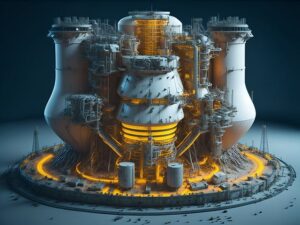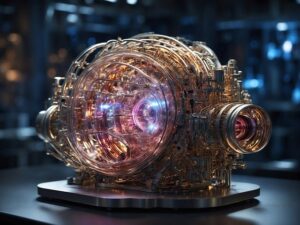Astronauts living on the Moon will need a lot of energy – but they can't take fuel supplies with them. A new generation of miniature nuclear reactors could be the answer.
Set in the 1970s, the TV series Space: 1999 begins like many sci-fi dramas – with an explosion. A nuclear explosion rips the Moon from Earth’s orbit, sending Moon Base Alpha and its inhabitants on a thrilling adventure through deep space.
Elon Musk and his plans
A young Elon Musk was clearly impressed. In 2017, when he envisioned SpaceX’s plans for a future moon base, he named it Alpha. Today, SpaceX is working with NASA to return humanity to the lunar surface as part of the US space agency’s Artemis program. But the planned lunar research camp has a more pragmatic working title: Artemis Base Camp.
International agreements
NASA and the US State Department have issued joint guidelines for peaceful lunar exploration in the form of the Artemis Accords. So far, 36 countries have signed up – including India, Japan, the UK, Canada, Australia, the United Arab Emirates and South Korea.
Call for research agencies
Regardless of which coalition builds the first base on the Moon, they will all need a reliable source of power. Many companies and space agencies around the world have come to the same conclusion.
Expert opinion
“The truth is that nuclear power is the only option for powering a moon base,” says Simon Middleburgh of the Nuclear Futures Institute at Bangor University in Wales.
How is the Moon?
A day on the Moon is not 24 hours long, like on Earth, but it is a month. Or, more precisely, 29.5 days. There are effectively two weeks of daylight followed by two weeks of darkness, with temperatures reaching -130°C. That's why all of the Apollo missions from 1969 to 1972 took place during the lunar day and near the Moon's equator, when temperatures were manageable and prolonged sunlight could power the scientific instruments and landers.
The reality of power supply
"Nuclear power is the only option," Middleburgh says. "We can't take fuel up there. The solar panels won't work. The diesel generators won't work, and the old-fashioned radiothermal generators aren't big enough to pack a punch."

New contracts
In 2022, NASA awarded contracts to Lockheed Martin, Westinghouse, and IX, a collaboration between Intuitive Machines and X-Energy. Intuitive Machines recently became the first commercial company to perform the first soft landing on the Moon in the United States in more than 50 years.
The future of nuclear technology
"We believe this because we have used nuclear technology in the past on space missions like Pioneer, Voyager and Cassini, where the systems far exceeded their original design life," says Shatel Bhakta, lunar architecture team leader at NASA's Johnson Space Center.
Opportunities and challenges
There are challenges in developing systems, testing them here on Earth, and operating them on the Moon, says NASA's Bhakta. "Natural and induced environments—such as launch vibrations, landing loads, extreme temperatures, lighting, and dust—are some of the main considerations. We need lunar power systems that are lightweight, highly reliable, and fault-tolerant that can handle these environments while providing service for many years."
What will the future look like?
We're moving to more miniaturized systems, says Middleburgh. "We're designing the most robust nuclear fuel possible, and it's based on something we've been working on in the UK for a number of years. It's called the Triso (TRi-structural ISOtropic) particle."

Safety precautions
These safety layers include carbon graphite and silicon carbide. Middleburgh says graphite is “radiation-tolerant at high temperatures, and it’s something we use on the leading edge of spacecraft, but we put it inside the reactor. It’s a nice material, but it’s not the ultimate material. I think we can do better. That’s what we’re working on with people around the world.”
“We’ve had a lot of nuclear renaissances, but we need opportunities to show that nuclear power is safe and emissions-free at the point of delivery,” says Middleburgh, who is very optimistic about the technology both in space and on Earth.
"The impact applications are incredible if we can show the public that nuclear energy can be delivered on time, on budget, and do exciting useful things – things that will save the world."



